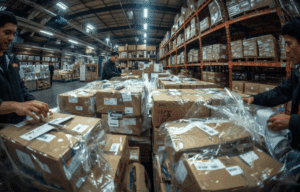This article is a contribution from Brooks Golba, VP, Fulfillment & Logistics Solutions at Qualfon.
For small and mid-sized brands, cash flow is everything. Every dollar sitting in inventory is a dollar you cannot put into marketing, product development, or anything else that drives growth. One of the biggest drivers of that problem is induction time, the period it takes for inventory to be received, processed, and made available for sale once it hits a fulfillment center.
Why Induction Time Hurts Cash Flow
When inventory sits waiting to be inducted, your capital is stuck. That creates real challenges:
- Buying inventory too early ties up cash that could be used elsewhere
- Delays in induction delay sales and slow down revenue recovery
- The longer products sit in transit or pending, the more you risk overstock or missing seasonal demand
I have seen brands buy into heavy demand forecasts only to have product hit fulfillment centers weeks late, right as demand falls off. The money is already spent, but the return does not come back fast enough to support growth.
The Hidden Cost of Rushing
To fight delays, many brands start paying for faster freight or premium placement. That solves the problem short term, but at the cost of margin. If you are paying more just to get products available for sale, your profitability takes a direct hit.
Why Hybrid Fulfillment Works
This is where hybrid fulfillment makes sense. A mix of Fulfillment by Amazon (FBA), Fulfillment by Merchant (FBM) or Seller-Fulfilled Prime (SFP), and a strong 3PL gives you flexibility.
- Use FBA for fast movers so your highest-converting products are live and available quickly
- Use FBM or a 3PL for slower or bulky SKUs so you are not paying unnecessary storage fees until you need to
- A good 3PL can consolidate your inventory and send to multiple Amazon Fulfillment Centers, cutting down transit time and keeping capital free until the moment you actually need to inject product into FBA
Plan Induction Into Your Forecasts
The best brands I work with treat induction time as part of their financial planning. They map out expected induction windows, pair that with sales velocity, and make smarter purchasing decisions. That kind of planning balances inventory risk, prevents cash from being locked up too early, and reduces the need for outside financing.
Bottom Line
Induction time is not just an operational detail. It is a financial lever. If you ignore it, your capital gets stuck and margins get squeezed. If you plan for it and build a hybrid fulfillment model around it, you protect liquidity, move faster when demand spikes, and give your brand room to grow.
About Qualfon
With 40 years of experience in inventory management, kitting, fulfillment, and shipping, and with two-day nationwide delivery to Amazon Fulfillment Centers, Qualfon helps brands design smarter fulfillment strategies that protect cash flow and profitability.
Thinking about partnering with a 3PL or reworking your fulfillment model? Talk to a Qualfon fulfillment specialist at sales@qualfon.com.




